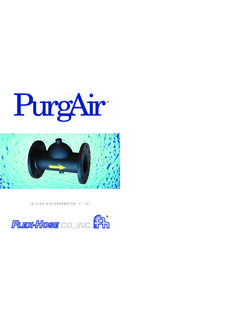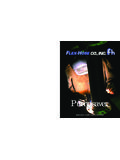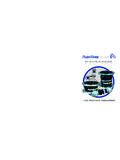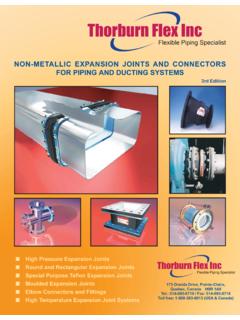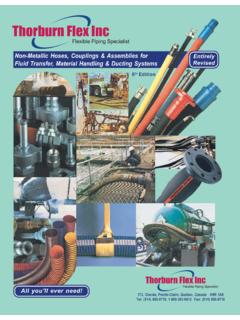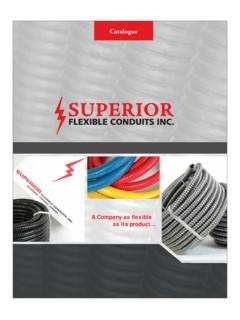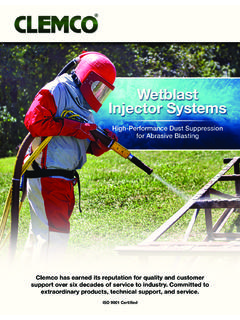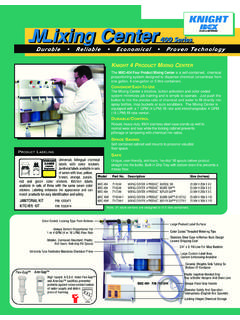Transcription of Building Seismic - Flex-Hose
1 Building Seismic Joint Seismic Seismic Restraint Restraint Tri- flex Loop Seismic Connection Typical bracing using Flex-Hose Co.'s IBC & ASCE Standard 7-05 Compliant Tri- flex Loop . The Tri- flex Loop Seismic Connection System meet the requirements of Chapter 2009 IBC & ASCE Standard Code Compliance - Seismic Design Requirements of ASCE Standard 7-05 code for total displacement. Compliant Tri- flex Loop Patented Technology From coast to coast, the 2009 International Building Code Meets the stringent requirements of the ASCE standards (IBC) & ASCE Standard 7-05 are requiring architects, for displacement requirements ASCE Standard 7-05.
2 D passe engineers and Building owners to adapt to new Building requirements related to Seismic regulations. Flex-Hose Company's Patented Tri- flex Loop design meets the displacement requirements as defined by Chapter of Chapter 17 - Seismic Design Requirements for the ASCE 7-05 code. It's three flexible sections allow it to Seismically Isolated Structures compensates movement in six degrees of freedom (three coordinates axes, plus rotation about those axes Displacement simultaneously from random Seismic shifts). Design Displacement. The design earthquake lateral displacement, excluding 2009 International Building Code (IBC) additional displacement due to actual and accidental torsion, required for design of AXIAL Passing the Test!
3 Section 1613-Earthquake Scope. the isolation system. COMPRESSION. Every structure, and portion thereof, including nonstructural PARALLEL OFFSET The New York State Center for Z AXIS Advanced Technology (CAT) at components that are permanently attached to structures and Total Design Displacement Rensselaer Polytechnic Institute, Troy, NY. their supports and attachments, shall be designed and Tri- flex Loop Flexible Coupling The design earthquake lateral displacement, including additional displacement due to constructed to resist the effects of earthquake motions in for Seismic Applications Testing accordance with ASCE 7, excluding Chapter actual and accidental torsion, required for design of the isolation system.
4 AXIAL EXTENSION Project No. A70614, October 1998. 14 and Appendix 11A. The Seismic design FRONT VIEW. The focus of the Flexible Coupling Evaluation is to category for a structure is permitted to be Total Maximum Displacement study the motion capabilities of the Flex-Hose determined in accordance with The maximum considered earthquake lateral displacement, including additional Tri- flex Loop. The product is deisgned to withstand Section 1613 or ASCE. large and irregular movements such as might be displacement due to actual and accidental torsion, required for verification of the caused by Seismic activities.
5 Testing was conducted stability of the isolation system or elements thereof, design of Building separation, by (1) analytically using finite element modeling LISTED and vertical load testing of isolator unit prototype. and computer simulation and (2) using physical testing. Tri- flex Loop . ASCE 7-05 Chapter 11. for combustible gases and The experimental results, in which the Flex-Hose flammable liquids NON-PARALLEL Tri- flex Loop exhibited signficantly superior ability 33NB Scope. Every structure, and portion thereof, includingnonstructural PARALLEL OFFSET. OFFSET Y AXIS.
6 WITH X AXIS to withstand repeated cyclic loading in three components, shall be designed and constructed to resist the effects of earthquake ROTATION dimensions. Based on the testing conducted on the motions as prescribed by the Seismic requirements of this standard. Certain Tri- flex Loop, it is likely that the Flex-Hose Tri- flex CSA standard B51 Loop will withstand limited application of certified. Inspected non- Building structures, as described in Chapter 15, are also within the scope and shall displacements in excess of those published by the and tested by the Technical Standards be designed and constructed in accordance with the requirements of Chapter 15.
7 Manufacturer without failure. and Safety Authority Requirements concerning alterations, additions, and change of use are set forth in FRONT VIEW. of Canada. SIDE VIEW The New York State Center for Advanced Appendix 11B. Existing structures and alterations to existing structures need only Technology (CAT) concluded the Flex-Hose Tri- flex comply with the Seismic requirements of this standard where required by Appendix 11B. Loop is found to be more likely to survive a Seismic event where large, three dimensional relative displacements of the ends of the coupling are Components Crossing the Isolation Interface.
8 Elements of seismically isolated Tri- flex Loop Specifications: involved. structures and nonstructural components, or portions thereof, that cross the isolation inter- The Tri- flex Loop patented design meets the displacement requirements as Tri- flex Loop's superior capabilities were proven in For Fire Protection Systems face shall be designed to withstand the total maximum displacement. defined Chapter 17 of ASCE Standard 7-05. It's three flexible sections allow computer-controlled, rigorous robotic testing at the it to compensate movement in six degrees of freedom (three coordinates axes, New York State Center for Advanced Technology (CAT) at Rensselaer Polytechnic Institute and are CYCLE TESTED FOR.)
9 Plus rotation about those axes simultaneously from 20,000. cycles random Seismic movements and displacements). available on a video. For your complimentary copy of the testing CD call us toll free 1-877-TRI- flex .. Tri- flex Loop Factory Cable Hanger Support Systems meet the requirements of the ASCE Standard 7-05 Chapter , ASCE Standard 7-05 Compliance - Component Support Requirements , for piping systems and component supports. Compliant Tri- flex Loop Cable Hanger Support System UL Listed From coast to coast, the 2009 International Meets the stringent requirements of the ASCE Standard 7-05 Chapter URC for ASCE Standard 7-05 , , for piping systems and component supports Building Code (IBC) and ASCE Standard 7-05 attaching to structure require architects, engineers and Building owners to adapt to new Building codes and standards Chapter 13 - Structural Design Requirements related to Seismic regulations.
10 These code for Non-Structural Components Tri- flex Loop Factory Cable Hanger UL Listed UL Listed standards also apply to the components utilized Assembly Kits meet the requirements of the Oval Sleeve Hanging Lug Seisimic to support flexible loops at Building separations. (URC) Cable Component Supports. Mechanical and electrical component supports ASCE 7-05 Chapters , on Elbow Rope/Cable The Tri- flex Loop UL Listed Cable Support Hanger and for component supports in that (including those with Ip = ) and the means by which they are attached to the System is simple and reliable and is in compliance they are designed for load rating and third component shall be designed for the forces and displacements determined in with ASCE Standard 7-05, Chapter , party tested.
